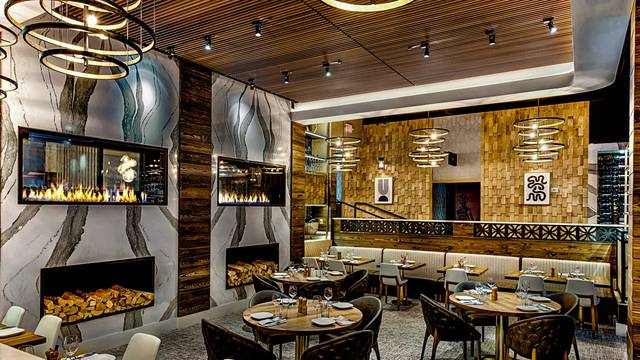Savor Genuine Eastern Cuisine With a Pan-Asian Spin for a Cooking Experience
Starting a cooking journey with genuine Eastern cuisine, boosted with a Pan-Asian spin, supplies a distinct chance to discover the rich tapestry of flavors that define the region's varied culinary traditions. This experience welcomes you to relish the charming equilibrium of preferences-- wonderful, salty, spicy, and sour-- integrated by aromatic natural herbs and spices. Think of the ingenious combination of Thai curry and ramen or the unforeseen joy of sushi burritos. As you contemplate these enticing recipes, think about the cultural narratives and historic influences that form them, each bite offering a story waiting to be discovered.

Discovering Pan-Asian Tastes
In the realm of worldwide gastronomy, Pan-Asian cuisine stands apart for its exceptional diversity and the unified interplay of tastes from numerous Asian cultures. This culinary technique commemorates the rich practices and special components found across the continent, producing a tapestry of tastes that is both appealing and rewarding. Trick to Pan-Asian food is its capacity to stabilize different flavors-- sweet, salted, spicy, and sour-- while highlighting the freshness and high quality of each ingredient.
From the umami-rich soy sauce of Japan to the fiery chili peppers of Thailand, Pan-Asian cuisine provides a considerable scheme of flavors. These elements are usually incorporated in innovative means, enhancing recipes with layers of intricacy. For example, using aromatic herbs such as lemongrass and cilantro, typical in Vietnamese and Thai food, adds a revitalizing brightness to recipes, while the incorporation of coconut milk delivers a velvety, rich texture.
The focus on fresh fruit and vegetables and fragrant spices guarantees that each meal is not just a feast for the taste buds yet also for the detects. Pan-Asian cuisine invites diners to begin on a cooking trip, checking out the substantial and differed landscapes of Oriental gastronomy with every bite.
Fusion Recipes to Try
While Pan-Asian food is commemorated for its typical flavors, the modern culinary landscape is progressively accepting combination recipes that mix these traditional components with influences from other areas. This ingenious technique not just honors the rich heritage of Asian culinary arts but additionally introduces novel preference experiences that interest modern tastes buds.
A prime instance of such a blend recipe is the Korean-Mexican taco, where marinaded bulgogi beef is wrapped in a warm tortilla, covered with kimchi and a zesty gochujang-infused salsa. This combination weds the strong, tasty tastes of Korea with the vivid, fresh aspects of Mexican cuisine. In a similar way, sushi burritos have gotten popularity, integrating the delicate creativity of Japanese sushi with the passionate, hand-held comfort of a burrito, often featuring fusion active ingredients like tempura shrimp and avocado with a drizzle of wasabi mayo.
Another noteworthy dish is Thai curry ramen, which infuses the velvety, aromatic spices of Thai curry right into the soothing broth of typical Japanese ramen, producing a harmonious blend that tantalizes the senses. These fusion recipes expand beyond plain novelty; they stand for a culinary discussion in between societies, motivating expedition and advancement on the planet of Pan-Asian food.
Important Components and Flavors
To genuinely appreciate Pan-Asian food, one have to understand the essential active ingredients and seasonings that create its foundation. This varied cooking style attracts from an abundant tapestry of Eastern customs, employing an unified mix of flavors and appearances.
Fragrant elements are essential, with garlic, lemongrass, and ginger being ubiquitous throughout various Pan-Asian recipes. These ingredients give a fragrant base that improves the intricacy of tastes. Flavors such as star anise, cardamom, and cinnamon introduce warmth and personality, echoing impacts from regions like China and India.

Food Preparation Methods and Tips
Grasping the art of Pan-Asian cuisine calls for experience with its distinct cooking strategies, each contributing to the vibrant tapestry of flavors this check my source cooking practice is commemorated for. Central to these techniques is the stir-fry, a rapid food preparation technique that protects the dietary honesty and dazzling shades of components. Using a wok, the stir-fry approach enables even heat distribution, crucial for attaining the characteristic texture and flavor balance of Pan-Asian dishes.
An additional essential strategy is steaming, especially widespread in Chinese cuisine. This gentle approach preserves the natural flavors and nutrients of active ingredients, making it optimal for fish and shellfish and veggies. Dumplings, a beloved staple, typically take advantage of steaming, causing soft, delicious structures.
Cooking, also essential, gives great smoky midsts to recipes such as Korean bulgogi or Japanese yakitori (Instagrammable restaurants Islamabad). This strategy frequently includes marinating ingredients, allowing tastes to permeate deeply prior to cooking over an open flame or warmer
Last but not least, grasping the art of balancing flavors-- wonderful, sour, salty, bitter, and umami-- is crucial. Appropriately layering these components can raise a dish from average to amazing, using a complex and pleasing cooking experience that personifies the significance of Pan-Asian food.
Eating Experiences Worldwide
Around the world, Pan-Asian food uses an unequaled dining experience, commemorated for its rich tapestry of flavors and vivid presentations. This cooking phenomenon has gone beyond social limits, recording the hearts and tastes of food fanatics worldwide. In multicultural cities fresh York, London, and Sydney, Pan-Asian restaurants function as fusions where cooking traditions from Thailand, Japan, China, and beyond converge, providing diners with a diverse mix of meals that highlight the area's diversity.
The global appeal of Pan-Asian food hinges on its capacity to offer both credibility and technology. Cooks skillfully marry conventional active ingredients such as lemongrass, soy sauce, hot wok and miso with modern techniques, causing meals that are both acquainted and refreshingly new. This blend enables diners to begin on a culinary trip that values heritage while welcoming modernity.
Furthermore, eating experiences are boosted through attentively developed settings that show the ethos of Pan-Asian appearances. From minimal Japanese-inspired insides to lively Thai-themed rooms, each dining establishment uses a distinct setting that enhances the cooking offerings. Consequently, clients are not simply consuming a meal you could try this out yet partaking in a social experience, making Pan-Asian dining a really worldwide sensation.
Verdict
The exploration of Pan-Asian cuisine offers a profound understanding of the elaborate interplay of tastes and cooking traditions throughout Asia. By accepting blend recipes such as Thai curry ramen and sushi burritos, the culinary journey not just highlights the adaptability of standard active ingredients yet likewise showcases ingenious modern-day methods. This gastronomic experience, improved by necessary spices and cooking methods, offers an one-of-a-kind possibility to value the cultural diversity and cooking virtuosity that define Pan-Asian food on an international scale.
Getting started on a culinary trip through genuine Eastern food, improved with a Pan-Asian spin, uses an one-of-a-kind opportunity to discover the abundant tapestry of tastes that specify the area's varied cooking traditions.In the realm of global gastronomy, Pan-Asian cuisine stands out for its remarkable diversity and the harmonious interaction of tastes from various Asian societies. Trick to Pan-Asian food is its capacity to balance different flavors-- sweet, salted, spicy, and sour-- while highlighting the freshness and quality of each ingredient.

Comments on “Asian Restaurant ISB: A Must-Try Spot for Food Lovers in Islamabad”